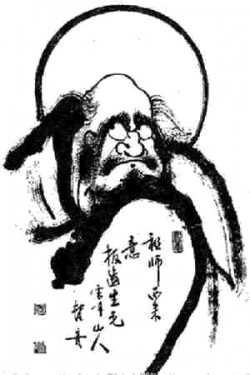
I’m a true believer.
I think our true nature exists under layers of delusion. Because it’s our true nature to be enlightened, we can find it.
This is what, I think, a serious study of Ch’an Buddhism, which in the west we usually refer to as “Chinese Zen” can bring to us. A Buddhism that is exciting and positive, rather than one that is dry and philosophical. A Buddhism based on actions rather than speculation.
Because let’s face it, sometimes Buddhism is boring.
Ch’an is not. It offers up the opportunity to dwell in enlightenment right now, not at some future time or in some future life. Enlightenment is there. Grab it.
Huineng, the sixth Zen Patriarch, was an illiterate woodcutter. He heard someone reciting a text called the Diamond Sutra and he suddenly entered the stream. After that, he found a Ch’an teacher and started cultivating the seed of Enlightenment. This is the authentic spiritual journey that many people have gone through. It exists throughout history. His story is really significant because it brings one important point into focus for us.
Anyone can do it. The path to awakening isn’t restricted to some lucky or noble few. It’s for everyone.
The purpose of Ch’an practice is Enlightenment, self realization, awakening to the absolute truth of reality. It’s a path of transformation instead of salvation.
We have a constructed image in our minds of who we are and what the world is. Ch’an is about being in the moment without the constructs. Dropping ego. Dropping the past and our thoughts about the future and engaging with the present moment. Master Dogen called it “The dropping away of body and mind.”
Easier said than done. Our minds want to do anything but stay in this moment. Ch’an involves learning to quiet our minds and penetrate through these layers of delusion. Ch’an is teaching our minds how to sit still.
We do this by following a set of principles: meditation, mindfulness, and morality.
Any discussion of Ch’an history has to involve Bodhidharma. The story of Ch’an says that it comes from the Buddha, the historical founder of Buddhism. The story says that he passed Ch’an teachings to one of his followers and it was passed from teacher to student for many many years. There’s not a lot of historical evidence for this. But that’s okay. What we do know is that it has been taught from teacher to student since about 1,600 years ago. The purpose of the teacher is both to set an example and to provide context for us for what’s happening as we progress along the path.
Ch’an as we know it started with Bodhidharma.
He taught what he called were the two entries to the path. He called them Conduct and Principle. He said both are necessary, but he clearly favored the teaching of Principle.
Conduct represents modifying our behaviors and spiritual cultivation. It also represents countering the three poisons: greed, anger and delusion.
He described four methods for entry through conduct.
1. Repaying wrongs: actions have consequences. Try to mitigate negative consequences from our actions as much as possible.
2. Adjust to circumstances: Accepting our conditions. Not being obsessed with changing our circumstances. It’s not that we shouldn’t try to change things. It’s only that when we only sit around thinking “When this happens I’ll be happy” that we have problems.
3. Non-seeking: Acting without attachment to success. Just doing our part.
4. Upholding the Dharma: Spreading the teachings to anyone that wants them.
Entry through Principle: Engaging our true nature. There are different methods of doing this. When we sit in silent meditation we are touching what my teacher calls the Empty Mind Ground. It’s available all the time because it is our true nature.
Our true nature is one with everything and the only reason we don’t see that is because we are in layers of delusion. When we meditate we clear some of that delusion. We have to dig ourselves out.
We train to realize our true nature. We investigate ourselves.
We just have to be present to perceive our true nature.
The path has been handed down for centuries.
In the early days it only consisted of transmission from one teacher to one student. They practiced together and over time the teacher would ask questions to help the student untie knots in their mind. Teachers would teach students to lay down thoughts and when the teacher could see a level of attainment, they would give dharma transmission, permission to teach and spread the dharma.
This changed over time. Teachers started taking many students and giving transmission multiple times. That’s not bad. We probably wouldn’t be here right now if that hadn’t happened.
Today there are lineages and organizations and schools. Many of them are very different. Lineages teach in their own style. Some require monasticism. Some, like the one I am in, discourage it. Ch’an has been evolving in different ways for hundreds of years.
Love elephant and want to go steady?
Sign up for our (curated) daily and weekly newsletters!
Author: Daniel Scharpenburg
Editor: Catherine Monkman
Photos: Wikimedia







Read 1 comment and reply